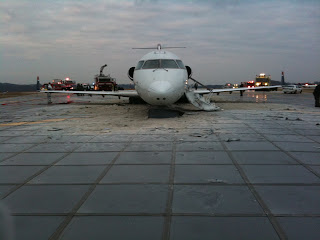by B. N. Sullivan

AirTran Airways pilots and flight attendants have been negotiating for years with the airline's management, hoping to achieve agreements for work contracts. After nearly six years of negotiations, the pilots have a new labor agreement in hand, however contract talks between AirTran and its flight attendants seem to be going nowhere.
Pilots
The pilots at AirTran Airways have ratified the
tentative contract agreement reached last month with the airline's management. The pilots' union, the Air Line Pilots Association (ALPA), announced the results of the ratification vote today, noting that 86.93 percent of those who cast ballots voted in favor of the agreement. ALPA said 93.28 percent of eligible AirTran pilots participated in the ratification vote.
According to a statement issued by ALPA, the new pilot contract enhances pay rates, quality of life, and career protections. Most elements of the contract will take effect on December 1, 2010.
“By approving this contract, our members have signaled that they are focused on the future and ready to close a contentious chapter in our airline’s history,” said Linden Hillman, chairman of the AirTran chapter of ALPA. “This deal will provide real improvements in our members’ lives and allow us to concentrate on the important work of merging two great companies.”
Flight Attendants
Last month -- around the same time that the pilots announced their tentative contract agreement --
AirTran's flight attendants filed for mediation of their contract talks by the National Mediation Board (NMB). The flight attendants, represented by the Association of Flight Attendants-CWA (AFA-CWA), commenced collective bargaining for a new contract in December of 2007.
AFA-CWA says that shortly after
Southwest Airlines announced in September that it would acquire AirTran, AirTran management approached the union requesting an abbreviated list of the flight attendants' greatest concerns in order to expedite negotiations.
AFA-CWA explains:
When presented with the union's "short list" proposal, company management responded with a counterproposal consisting mostly of existing contract language and minimal pay increases. In addition, they failed to address the most basic work, duty and rest provisions. AFA-CWA rejected management's proposal and filed for mediation services from the National Mediation Board the following day.
Despite AirTran's acquisition by Southwest, AirTran flight attendants will continue to work under the AirTran contract for at least another two years. AFA-CWA points out that under the Railway Labor Act, "this future change in ownership does not negate the carrier's obligation to negotiate now with its flight attendants in good faith."
"It is incomprehensible that our flight attendants are subjected to the worst work rules of any major airline, while it is those same flight attendants' hard work that has earned AirTran numerous awards and accolades," said Alison Head, AFA-CWA AirTran President.
"Management has worked with its pilots to negotiate an acceptable contract to work under through the Southwest merger process - but refuses to offer some of the same fair work rules to its flight attendants., Ms. Head continued. "Why would you extend fair work rules to one group of safety professionals and not to the other?"
In order to publicly demonstrate their frustrations over the stalled contract negotiations, AirTran flight attendants plan to picket outside Atlanta's Hartsfield-Jackson International Airport this coming Wednesday, November 24, 2010.
 On Tuesday evening, November 30, 2010, an American Airlines Boeing 737-800 aircraft went off the runway at Montréal-Trudeau Airport. The aircraft, operating as American Airlines Flight AA802, had just arrived at Montréal after a scheduled passenger flight from Dallas-Fort Worth. No one was injured.
On Tuesday evening, November 30, 2010, an American Airlines Boeing 737-800 aircraft went off the runway at Montréal-Trudeau Airport. The aircraft, operating as American Airlines Flight AA802, had just arrived at Montréal after a scheduled passenger flight from Dallas-Fort Worth. No one was injured.








